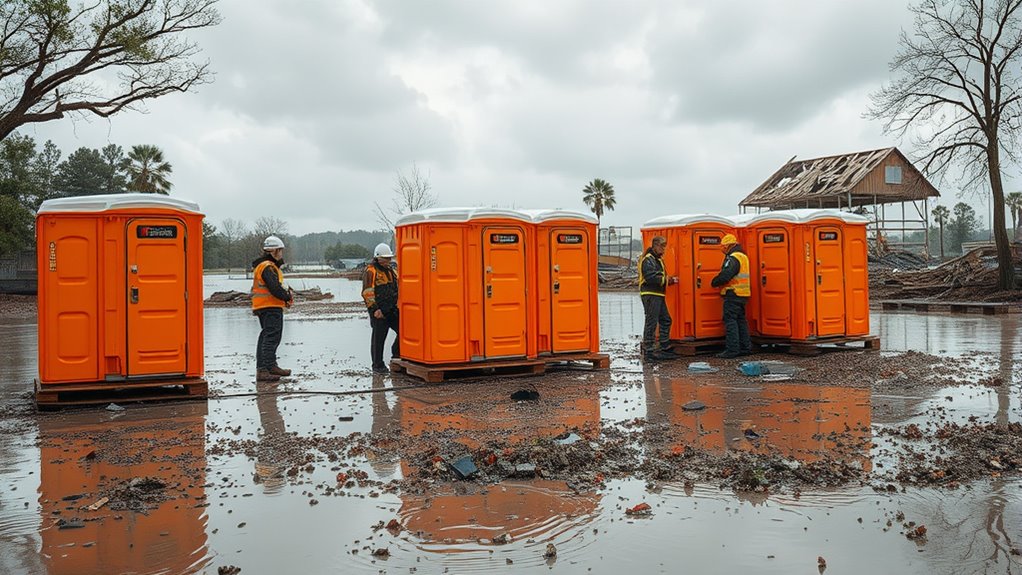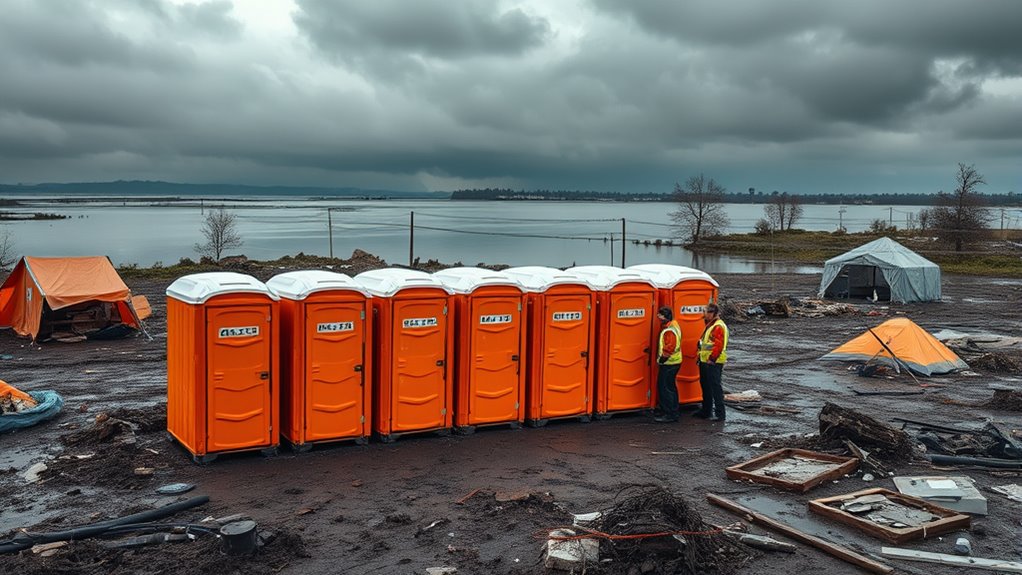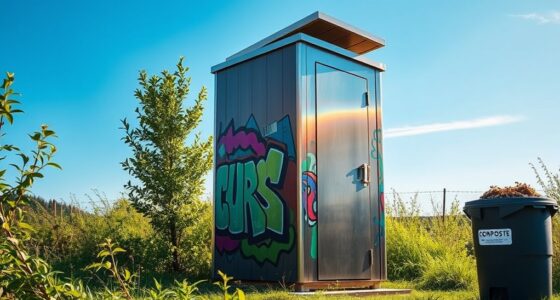During natural disasters, portable sanitation plays a crucial role in preventing disease outbreaks and safeguarding public health. Proper planning ensures quick deployment of toilets, handwashing stations, and waste management systems, reducing contamination risks. Training personnel in setup and maintenance is essential, along with community education on hygiene practices. Maintaining these facilities helps protect vulnerable populations and keeps the environment safe. To discover more about effective strategies and lessons learned, keep exploring how portable sanitation can enhance emergency responses.
Key Takeaways
- Rapid deployment of portable sanitation prevents waterborne disease outbreaks during disaster response.
- Proper planning and pre-positioning ensure timely access to sanitation solutions in emergencies.
- Training personnel in setup and maintenance maximizes the effectiveness and safety of portable units.
- Community education on hygiene practices enhances sanitation efforts and reduces health risks.
- Regular monitoring and cleaning of portable sanitation units are critical to maintaining hygiene and preventing contamination.

Have you ever wondered what separates successful emergency responses from chaotic failures? One critical factor is how well you manage sanitation during a disaster. When natural calamities strike, disrupted sanitation infrastructure can quickly turn a crisis into a health disaster. Without proper sanitation solutions, waterborne diseases like cholera, dysentery, and typhoid can spread rapidly, compromising the health of vulnerable populations. That’s why portable sanitation becomes essential in emergency situations. It offers a practical way to prevent the contamination of water sources and reduce the risk of disease outbreaks.
In the immediate aftermath of a disaster, the destruction of existing sanitation infrastructure leaves communities vulnerable. Sewage systems may be damaged or overwhelmed, and access to clean water becomes scarce. If you don’t act fast to implement portable sanitation options, you increase the likelihood that contaminated water will be used for drinking, cooking, or washing, fueling the spread of waterborne diseases. This situation not only worsens the health crisis but also hampers rescue and recovery efforts. Proper sanitation isn’t just about hygiene; it’s a matter of preventing illness and saving lives.
You must recognize that quick deployment of portable toilets, handwashing stations, and waste disposal units can considerably curb the spread of disease. These units are designed to be easy to set up and maintain, providing immediate relief to affected populations. By establishing such systems early, you create a barrier against contamination of water sources, which is essential when the regular sanitation infrastructure is compromised. Additionally, these solutions help maintain dignity and hygiene for displaced individuals, reducing the psychological toll on communities already under stress.
Furthermore, integrating portable sanitation into your emergency response plan requires foresight. You need to guarantee supplies are available beforehand and that personnel are trained in proper setup and maintenance. Regular monitoring and cleaning of portable units prevent them from becoming sources of infection themselves. Educating the community about hygiene practices and proper waste disposal also plays an important role in limiting waterborne diseases. Implementing HEPA filtration and other effective technologies can further enhance air quality and reduce airborne contaminants, supporting overall health in disaster zones. The goal is to create a safe environment where people can focus on recovery rather than battling preventable illnesses.
Frequently Asked Questions
How Are Portable Toilets Disposed of After a Disaster?
After a disaster, you handle portable toilet disposal through proper waste management. You typically remove the tanks, clean and disinfect them, and then transport the waste to authorized treatment facilities. This process minimizes environmental impact by ensuring waste doesn’t contaminate water sources or soil. It’s essential to follow local regulations and guidelines, maintaining sanitation standards and protecting public health during recovery efforts.
What Are the Costs Associated With Emergency Portable Sanitation?
Imagine your budget as a garden, and costs are the seeds you plant. When planning emergency portable sanitation, you do a cost analysis to understand expenses like rental, delivery, and maintenance. These costs can vary based on disaster scale and needs. Proper budget planning guarantees you have enough resources, avoiding surprises. Being prepared means knowing what to expect, helping you allocate funds wisely for quick, effective response.
How Do Portable Units Accommodate Disabled or Elderly Individuals?
You’ll find that portable units accommodate disabled or elderly individuals through accessibility features like ramps, handrails, and wider doorways. Specialized equipment such as grab bars and lower sinks also make using these facilities easier and safer. These thoughtful designs guarantee everyone’s needs are met, providing dignity and independence during challenging times. By prioritizing accessibility, portable sanitation units become inclusive, supporting all individuals regardless of mobility challenges.
What Training Is Required for Emergency Sanitation Personnel?
You need proper training certification for emergency sanitation personnel to guarantee they’re prepared. This includes understanding safety protocols, proper sanitation techniques, and equipment handling. Your training should cover emergency response procedures, hygiene standards, and accessibility needs. Certification verifies that you’re knowledgeable and competent, reducing health risks. Continuous education is also essential to stay updated on best practices, ensuring effective and safe sanitation services during natural disasters or other emergencies.
How Is Sanitation Maintained During Prolonged Disaster Responses?
During prolonged disaster responses, you guarantee proper sanitation by regularly monitoring water quality and waste management systems. You set up portable sanitation units, maintain them properly, and disinfect to prevent contamination. You also manage waste disposal carefully, following safety protocols to protect public health. By staying vigilant and adapting to changing conditions, you keep sanitation services effective, reducing health risks and supporting community recovery throughout the disaster response.
Conclusion
While natural disasters can cause chaos and destruction, proper portable sanitation can bring much-needed relief and dignity. You might think chaos is unavoidable, but with effective sanitation solutions, you restore order and health amid the turmoil. It’s the stark contrast between devastation and dignity that highlights the importance of being prepared. Remember, even in the worst moments, a simple portable toilet can make a world of difference—proof that small solutions can combat big challenges.








